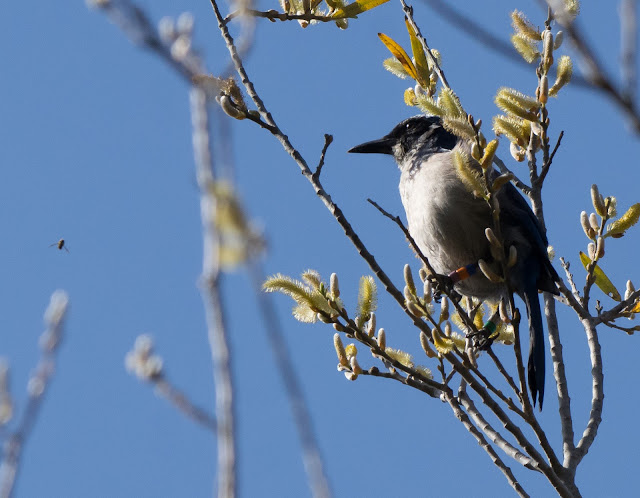What is 'Target Birding'? It probably means many things to different birders, but to me, it means making a trek to focus on one particular species of bird. The one species might mean a rarity that has shown up in the most unlikely place such as the Lesser Sand Plover that showed up in northern Arizona last fall. Or it might mean chasing a bird that has a limited range and is endemic to a particular area or region. Such was the case this past week for me and I made a trip to southern California to 'target' an endemic species.
This species for me was the Island Scrub-Jay that is found only on Santa Cruz Island which is part of the Channel Island National Park off the coast of California near Ventura. The only access to Santa Cruz Island is by sea via a boat and taking the ferry was my only option. I opted to take the ferry to Prisoner's Harbor where most reports were coming in for the ISSJ (banding code for Island Scrub-Jay), and where most people recommend for seeing this bird. The ferry does stop at Scorpion Bay before venturing on to Prisoner's Harbor and that is the point that most people got off. My primary focus was to find the Island Scrub-Jay, so that is what I did before focusing on other birds and interesting flora and fauna. I could hear the jays calling from the hillsides, but those hillsides were on the Nature Conservancy property where we were not allowed access. Eventually, 2 of them ventured down to the stream and I finally got my first views of them and managed to capture a few photos.
Island Scrub-Jay
Allen'a and Anna's Hummingbirds were fairly common on the island, and since Anna's is a species I get in my back yard, I focused on the Allen's Hummingbirds. I have seen this species once before in southern California, but this was a long time ago and I had never gotten any photos. It was a treat to see these and observe their behavior and listen to them for a change.
Allen's Hummingbird - Male
During my stay on the island, I was constantly hearing a call that I was unfamiliar with and eventually I was able to track it down and found out it was an Orange-crowned Warbler and they were plentiful. This is a sub-species (sordida) that is endemic to the Channel Islands and they look different and sound different than the other sub-species of Orange-crowned Warblers.
Orange-crowned Warbler (sordida)
There were also many sea birds that we observed on the ocean from the ferry and also from land. Birds on the ferry were almost impossible to identify and photograph as this boat was fast moving and they were not focusing on the pelagic birds. Only when it slowed down or stopped for whales or dolphins, I was able to snap off a few photos.
Brandt's Cormorant
Black-vented Shearwater
Caspian Tern
Common Murre
The ferry did not focus on sea birds, but it would stop when ever they spotted mammals in the ocean such as whales, dolphins, and seals. Of course everyone on the boat got excited in seeing whales, as did yours truly! I had the privilege to see 2 groups of these whales from the boat; a group of 2 and then later a group of 6. Pacific Gray Whales migrate down the coast of California this time of year to areas off the coast of Baja California where females give birth to calves.
Pacific Gray Whale
Also VERY numerous out on the water were large groups of Common Dolphins. One group we encountered was estimated at over 2000 by the crew and they would swim up to ans around the boat as if playing games. They are very fast and nimble and hard to photograph, but what a wonderous sight to see.
Common Dolphin
Elephant seals were also seen, specially on the ride out to the island in the early morning. They will raise their flippers out of the water to expose them to the sun for warmth.
Elephant Seal
On the island I found this butterfly that I had never seen before and after a little research, I came up with an identification of Gray Hairstreak. A very striking butterfly in my opinion.
Gray Hairstreak
I was also impressed by the Giant Coreopsis that grows on the Channels Islands. This variety is almost like a small tree as it grows up to 3½ feet tall with a trunk that is almost 4 inches in diameter.
Giant Coreopsis
More adventures of my birding trip will be covered in another post in the very new future. The rest of the trip involved birding on the mainland and chasing a couple of introduced species that have established some breeding regularity in the United States.



















































